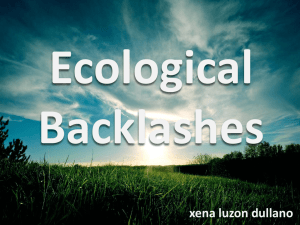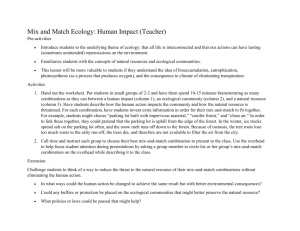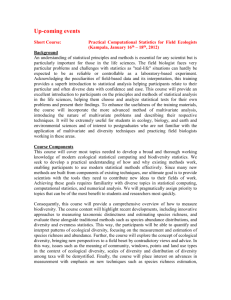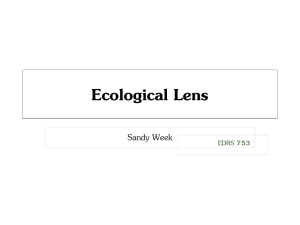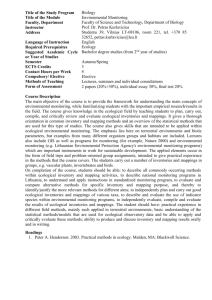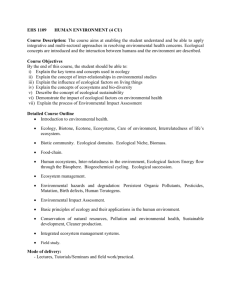Sydney Basin Bioregion ecological communities: listing assessment
advertisement
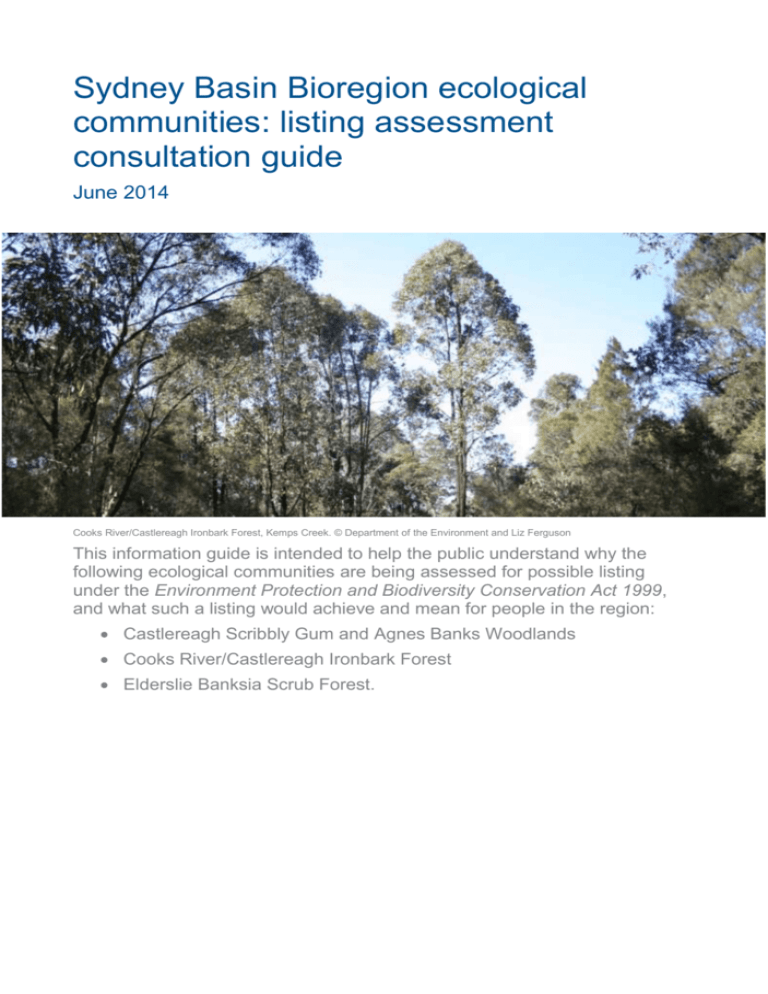
Sydney Basin Bioregion ecological communities: listing assessment consultation guide June 2014 Cooks River/Castlereagh Ironbark Forest, Kemps Creek. © Department of the Environment and Liz Ferguson This information guide is intended to help the public understand why the following ecological communities are being assessed for possible listing under the Environment Protection and Biodiversity Conservation Act 1999, and what such a listing would achieve and mean for people in the region: Castlereagh Scribbly Gum and Agnes Banks Woodlands Cooks River/Castlereagh Ironbark Forest Elderslie Banksia Scrub Forest. In summary: The Castlereagh Scribbly Gum and Agnes Banks Woodlands, the Cooks River/Castlereagh Ironbark Forest and the Elderslie Banksia Scrub Forest ecological communities of the Sydney Basin Bioregion have been nominated for protection under Australia’s national environmental law, the Environment Protection and Biodiversity Conservation Act 1999 (EPBC Act). The Castlereagh Scribbly Gum and Agnes Banks Woodlands, and the Elderslie Banksia Scrub Forest ecological communities were placed on the Finalised Priority Assessment List in 2011, as part of the Hinterland Sand Flats Forest and Woodland of the Sydney Basin Bioregion nomination. The Cooks River/Castlereagh Ironbark Forest was placed on the Finalised Priority Assessment List in 2012. A scientific assessment is being undertaken to re-define and gather evidence on the current threat status of the ecological communities. Public consultation and input from Councils, Traditional Owners, land managers and other interested parties is an important and valuable part of the assessment process. Consultation is open until Wednesday 6 August 2014. The Minister for the Environment will make the decision on whether to list the ecological communities by mid February 2015. If eligible for listing under the EPBC Act there would be benefits to the environment and associated ecosystem services, and benefits and opportunities for groups with an interest in the ecological communities. Listing would help promote a coordinated, ecosystem-scale approach to threat abatement in the region and for threatened species that are found within the ecological communities. Listing under the EPBC Act means that an activity that is likely to have a significant impact on an ecological community needs to be assessed and approved. For example, activities that involve permanently clearing large areas of intact and high-quality native vegetation for new residential and industrial areas or other infrastructure. The EPBC Act is not designed to stop people using their land. Existing and routine landholder and agricultural activities, and actions previously approved under other legislation are generally exempt from the EPBC Act. Public consultation Hinterland Sand Flats The Hinterland Sand Flats Forest and Woodland of the Sydney Basin Bioregion ecological community was placed on the 2011 Finalised Priority Assessment List (FPAL). The ecological community is undergoing assessment under the Environment Protection and Biodiversity Conservation Act 1999 (EPBC Act). Public consultation on this nomination was undertaken in 2013, and expert consultation has also been undertaken. This assessment has resulted in a refined version of the nomination, which now consists of: The Castlereagh Scribbly Gum and Agnes Banks Woodlands of the Sydney Basin Bioregion ecological community (which includes the Castlereagh Scribbly Gum Woodland and Agnes Banks Woodland vegetation units); and The Elderslie Banksia Scrub Forest of the Sydney Basin Bioregion ecological community. Castlereagh Scribbly Gum Woodland, Voyager Point. © Department of the Environment and Liz Ferguson Cooks River/Castlereagh Ironbark Forest This ecological community was placed on the 2012 Finalised Priority Assessment List (FPAL). The ecological community is undergoing assessment under the EPBC Act. Expert consultation is in progress. Public consultation process The Castlereagh Scribbly Gum and Agnes Banks Woodlands, Elderslie Banksia Scrub Forest and Cooks River/Castlereagh Ironbark Forest ecological communities are now undergoing assessment for potential listing as threatened ecological communities under the EPBC Act. Discussions with landholders, experts, government agencies and stakeholder groups are a vital part of the assessment process. A formal public consultation period for this ecological community is now open and will close on Wednesday 6 August 2014. The Threatened Species Scientific Committee (the Committee) is seeking comments on the draft descriptions for the ecological communities. All comments received are forwarded to the Committee and the Minister for the Environment for consideration. Once the Committee has completed its scientific assessment, its advice on whether to list and the likely conservation status will be forwarded to the Minister for the Environment. It is the Minister who decides if an ecological community should be listed and which conservation category applies. Under the EPBC Act, the Minister’s listing decision is made on whether the ecological community meets the listing criteria and whether listing will benefit its survival. What is an ecological community under national environmental law? Australia’s national environmental law, the EPBC Act, protects what are known as Matters of National Environmental Significance. The Act is only triggered if there is likely to be a significant impact to any of these matters. Threatened species and ecological communities are Matters of National Environmental Significance. The EPBC Act defines an ecological community as an assemblage of native species that inhabits a particular area in nature. They often relate to types of native vegetation, such as a certain kind of grassland, woodland or forest. The native plants and animals within an ecological community have different roles and relationships that, together, contribute to the healthy functioning of the environment. Protecting native communities also protects ecosystem services such as good quality air and water; healthy soils; natural prevention or control of erosion and salinity; shelter and feed for stock; and the storage of carbon. These all contribute to better productivity of our land and water, which benefits people and society. Human settlements and infrastructures where an ecological community formerly occurred do not form part of the natural environment and are therefore not part of the ecological community—e.g. sites where an ecological community has been cleared or replaced by crops, exotic pastures or developments. This also applies to sites where the ecological community exists in a highlydegraded or unnatural state. For instance, cropping lands and exotic pastures or areas where much of the native vegetation has been replaced by exotic species, and are no longer part of a natural ecological community. What is the listing assessment process? Under the EPBC Act, members of the public can nominate an ecological community for listing during a formal nomination period that is open between November and March each year. Nominations received are prioritised for assessment by the independent Threatened Species Scientific Committee (the Committee) and the final priority assessment list (FPAL) is approved by the Australian Government Environment Minister. Priority nominations undergo a thorough scientific assessment by the Committee. The assessment involves clarifying the definition of the ecological community, determining where it occurs, and rigorously assessing its eligibility for listing as nationally threatened. An ecological community must be demonstrated to be significantly impacted by identified threats. It should also be shown that if these threats are not managed, there is a risk that the ecological community may be changed irreversibly and its natural composition and/or function could be lost forever. Three categories exist for listing ecological communities, depending on the level of extinction risk: vulnerable, endangered or critically endangered. All assessments undergo public consultation on the proposal to list. What is the Castlereagh Scribbly Gum and Agnes Banks Woodlands ecological community? The ecological community is mainly found within the Cumberland Plain, with the exception of some patches occurring just outside of the plain near Holsworthy (see distribution map). The entire community is located within the Sydney Basin Bioregion. Local Government Areas within which the community occurs include Penrith, Blacktown and Liverpool. The ecological community occurs primarily on Tertiary sands and gravels of the Hawkesbury-Nepean river system. The Agnes Banks Woodland component primarily occurs on Aeolian (wind-blown) sands overlying Tertiary alluvium. Soils are typically low in nutrients, unlike more recent alluvial deposits. Sediments may be almost pure sand, with other sand deposits often transitioning to, or including, areas of gravel and clay. The Castlereagh Scribbly Gum and Agnes Banks Woodlands ranges from woodland to low open-woodland with the canopy species typically 10-15 m tall. The canopy contains, and is often dominated by, one or more of the following species: Angophora bakeri (Narrow Leaved Apple), Eucalyptus racemosa (Narrow-leaved Scribbly Gum) and E. parramattensis subsp. parramattensis (Parramatta Red Gum). Melaleuca species including M. decora (Paperbark) may also be prominent in the canopy (or mid layer) of the ecological community. Eucalyptus fibrosa (Red Ironbark) is occasionally present in the canopy. The ecological community’s understorey has a prominent and diverse layer of sclerophyll shrubs. It typically has a patchy ground cover of sedges and grasses. However, in areas of poorly drained soil there may be less species diversity in the mid layer and the ground layer may contain a high diversity of sedges and grasses. There may be some variation in species composition and abundance across the range of the ecological community. For example, varying abundance of Melaleuca and Banksia species in the canopy and shrub layer. In addition, the Agnes Banks vegetation occurs on Aeolian sand and can contain a number of species reminiscent of communities closer to the coast, such as Dillwynia glaberrima, Ricinocarpos pinifolius (Wedding Bush) and Banksia aemula (Wallum). Melaleuca decora (Paperbark). © Department of the Environment and Liz Ferguson What is the Elderslie Banksia Scrub Forest ecological community? Elderslie Banksia Scrub Forest is found on the Cumberland Plain in the Camden Local Government Area, south of the township of Camden and in proximity to the Nepean River. The ecological community occurs at low altitudes of around 50 m above sea level, on sandy soils overlying tertiary alluvium. The vegetation structure is low woodland (also described as open scrub and or scrub-forest), less than 15 m tall with a prominent shrub layer. The canopy is usually dominated by Banksia integrifolia subsp. integrifolia (Coast Banksia), but Eucalyptus botryoides (Bangalay) may dominate in the wettest areas. Other typical canopy species may include: Angophora subvelutina (Rough-barked Apple), Eucalyptus baueriana (Blue Box) and Melaleuca decora (Paperbark). Characteristic mid layer species include Acacia decurrens (Black Wattle, Sydney Green Wattle, Boo'kerrikin (D'harawal)), A. implexa (Hickory Wattle, Weetjellan (D'harawal)), A. ulicifolia (Prickly Moses), Breynia oblongifolia (Coffee Bush), Dillwynia glaberrima (Smooth-leaved Dillwynia), Duboisia myoporoides (Corkwood), Pimelea linifolia subsp. linifolia (Slender Riceflower) and Ricinocarpos pinifolius (Wedding Bush). Ground layer plants include Dianella caerulea, Dianella revoluta, Gahnia clarkei (Tall Sawsedge), Lomandra species and Pteridium esculentum (Common Bracken). The ecological community provides habitat for a range of fauna including the following threatened species: Chalinolobus dwyeri (Large-eared Pied Bat), Lathamus discolour (Swift Parrot), Meridolum corneovirens (Cumberland Land Snail), Miniopterus schreibersii oceanensis (Eastern Bentwing Bat), Mormopterus norfolkensis (Eastern Free-tail Bat), Pteropus poliocephalus (Grey-headed Flying Fox) and Scoteanax rueppellii (Greater Broad-nosed Bat). What is the Cooks River/Castlereagh Ironbark Forest ecological community? The Cooks River/Castlereagh Ironbark Forest in the Sydney Basin Bioregion is a dry sclerophyll open-forest to low woodland. The majority of the community is found on the Cumberland Subregion north and west of Botany Bay towards Richmond. The largest patches occur in the Castlereagh and Holsworthy areas. Smaller remnants occur in the Kemps Creek area and in the eastern section of the Cumberland Subregion (e.g. upper Cooks River Valley). The community occurs on clay-rich soils and is dominated by Eucalyptus fibrosa (Broad-leaved Ironbark) and Melaleuca decora (Paperbark), with E. longifolia (Woollybutt) often present. The shrub layer is relatively dense, and is dominated by M. nodosa (Prickly-leaved Paperbark) and Lissanthe strigosa (Peach Heath), and to a lesser extent M. decora. It also includes a range of ‘pea’ flower shrubs, including Dillwynia tenuifolia, Pultenaea villosa (Hairy Bush-pea) and Daviesia ulicifolia (Gorse Bitter Pea). The ground layer is relatively sparse and commonly includes Entolasia stricta (Wiry Panic), Lepidosperma laterale, Opercularia diphylla, Dianella revoluta subsp. revoluta (Blue Flax-Lily), Themeda australis (Kangaroo Grass), Microlaena stipoides var. stipoides (Weeping Grass) and Pratia purpurascens (Whiteroot). The ecological community also provided habitat for a range of birds, including the nationally vulnerable Turnix varius (Painted Button Quail), and Falcunculus frontatus (Crested Shrike Tit). Substrate for Cooks River/Castlereagh Ironbark Forest, Kemp’s Creek. ©Department of the Environment and Liz Ferguson Why are these ecological communities important? Much of the vegetation of the region west of Sydney has been cleared, fragmented or heavily modified, and with this, many species have become locally, regionally or globally extinct. In particular, fewer mammal species are now found in this area. For many of the plant and animal species that remain, remnants of ecological communities are critical for their survival. For example, the ecological communities provide habitat and food resources for the assemblage of woodland birds that occurs in the region, many of which are threatened. Connectivity can be a particular issue for threatened fauna and flora in the region, some of which cannot traverse poorly vegetated urban areas; consequently patches of the Castlereagh Scribbly Gum and Agnes Banks Woodlands, Elderslie Banksia Scrub Forest and Cooks River/Castlereagh Ironbark Forest are likely to be essential to facilitating movement of species through the landscape and preventing their extinction. Some of the Eucalyptus species found in the canopy of the ecological communities play a particularly important role in supporting some birds and mammals through winter, by providing nectar at this time. This can be important for both resident species such as the endangered Regent Honeyeater and for those that migrate along Australia’s east coast (e.g. the endangered Swift Parrot). What are the benefits of listing an ecological community as nationally threatened? There are a number of benefits to listing ecological communities under Australia’s national environmental law: Listing an ecological community can help protect the landscapes that provide connectivity, corridors and refuges essential to protect and improve the ecological function, health and biodiversity of the region. It can protect habitat critical for refuge and recruitment of threatened species and for other species that are under pressure in the region. In turn, this helps foster the ecosystem services associated with an ecological community. In the case of the Castlereagh Scribbly Gum and Agnes Banks Woodlands, Elderslie Banksia Scrub Forest and the Cooks River/Castlereagh Ironbark Forest ecological communities, the listing would: o provide landscape-scale protection that complements existing national protection of many threatened plants and animals that are found within the communities; and, o protect the environmental values, including all the ecosystem functions and services associated with the ecological communities, which contributes to the long-term productivity and resilience of the landscape. Listing threatened ecological communities helps protect them from future significant human impacts that may cause further decline. The aim of the national environment law is to ensure the matters of national environmental significance are given due consideration, along with broader economic, social and other issues in the planning of any large projects. Where possible, significant adverse impacts to the environment should be avoided, or the impacts mitigated, reduced or offset, when unavoidable. National listing encourages agencies and community/Landcare groups to apply for environmental funding opportunities for conservation and recovery works. The Australian Government has a variety of funding programmes to encourage land managers to continue to conserve biodiversity and ecosystem services on their properties. A conservation advice, published at the time of listing, provides guidance and options for environmental decisionmaking, including rehabilitation and conservation initiatives in the region. Eucalyptus fibrosa (Broad-leaved Ironbark) in Cooks River/Castlereagh Ironbark Forest, Kemp’s Creek. ©Department of the Environment and Liz Ferguson Will activities that happened before listing or ongoing and routine activities need to be referred? Activities which were routine or began before 2000 may generally continue without referral/approval. Such exemptions apply to activities that were either already legally approved (termed 'prior authorisation'), or are ongoing (termed 'continuing use'). Land management and other practices undertaken in line with the State native vegetation laws and guidelines are also typically exempt from the EPBC Act. Council, farming and other practices which are unlikely to require approval from the Australian Government include the following: ongoing horticultural or cropping activities maintaining existing fences, roads, internal access tracks and firebreaks maintaining existing gardens and orchards maintaining existing dams or water storages replacing and maintaining sheds, yards and other existing buildings controlling weeds by hand or minor group machinery; and management of feral pest species. What actions might need to be referred for approval under the EPBC Act? The environment assessment process under the EPBC Act involves: referral (only if the action is likely to have a significant impact) assessment (usually involves developing an Environmental Impact Statement with the proponent), and approval from the Minister (who considers the environmental, social and economic factors involved). New, changed or intensified activities that are likely to have a significant impact on a listed ecological community (i.e. an irreversible or long-term detrimental impact) may need Australian Government approval and should therefore be referred. These are likely to include: permanently clearing large areas of the ecological community (recognising that in many listed communities, the threat from clearing is the result of past actions); introducing grazing to native vegetation areas that have not previously been grazed or changing from grazing to cropping within the ecological community; substantially changing or intensifying methods of weed control or fertiliser use in or adjacent to a patch of the ecological community and that exacerbates detrimental impacts to native vegetation, and major developmental works within or near to a patch of the ecological community. These lists do not include all actions that may/may not require approval. Where can I get further information? Information on the proposed listing of the ecological communities: [insert hyperlink] The listing process: www.environment.gov.au/biodiversity/threatened/index.html The EPBC referral and approval process: www.environment.gov.au/epbc/ Australian Government natural resource management initiatives: www.nrm.gov.au/ The department’s Community Information Unit: by phone on 1800 803 772 (freecall), or email at ciu@environment.gov.au




